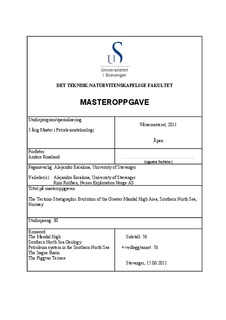| dc.description.abstract | A 3D seismic cube combined with well data from ten exploration wells are used to form a model of the tectono-stratigraphic evolution of the Greater Mandal High Area, Southern North Sea, Norway.
The data defines the crystalline Mandal High as an elongated, s-shaped, SE-NW trending horst. The first sub aerial exposure of the horst was in the Triassic, lasting up until the Upper Cretaceous flooding. Deformations and lineaments dating back to the Caledonian orogeny are identified. The two main lineaments have a near N-S and NE-SW orientation.
Seven chronostratigraphic sequences have been defined: The Lower Permian with rifting, doming and volcanic activity in a continental environment, flooding in the Upper Permian and subsequent deposition of the Zechstein salt, rifting in a continental setting of the Triassic, uplift and erosion in the Middle Jurassic leading to deposition in shallow marine and delta environments, rifting and transgression in a deep marine environment during the Upper Jurassic, a post rift phase in a marine environment of the Lower Cretaceous and lastly; flooding, deposition of chalk groups and inversion in the Upper Cretaceous.
Three fault families consisting of Lower Permian normal faults families are defined with the following orientation: Fault family 1 – near N-S, fault family 2 – NE-SW, fault family 3 – W-E. These faults inherit the structural grain first established by the Caledonian folding. In addition, fault family 4 consisting of NW-SE oriented normal faults, with large displacements are associated with the Upper Jurassic rifting. They were reactivated in the Upper Cretaceous as reverse fault, creating inverted structures. Fault family 5 is observed in all sequences above the Upper Permian, has various orientations and is associated with salt tectonics.
Salt mobilized during three phases: The Triassic, Upper Jurassic and Upper Cretaceous, and served as an important structural and stratigraphic control. Salt bodies were created on weakness zones first established during the Caledonian folding, and deformed above layers
By serving as an analogue to the Utsira High, the Mandal High might comprise a set of petroleum plays, including fractured crystalline basement and shallow marine systems evolving around the high. A source rock kitchen is proven to the west in the Feda Graben, and the south in the Danish Feda Graben. Hydrocarbons may migrate from these areas into the Greater Mandal High Area, but migration is further complicated by the possibility of both the Mandal High and the salt structures acting as migration barriers. | no_NO |
